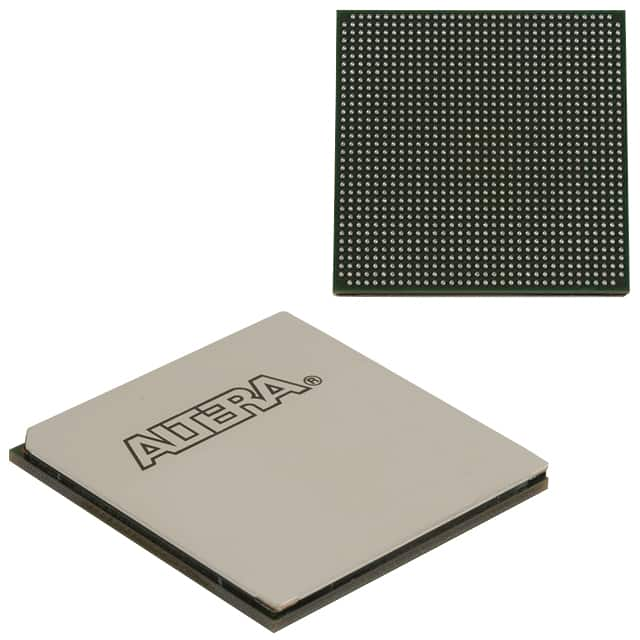5SGXEA3H3F35I3N
Product Overview
Category
The 5SGXEA3H3F35I3N belongs to the category of Field Programmable Gate Arrays (FPGAs).
Use
FPGAs are integrated circuits that can be programmed and reprogrammed to perform various digital functions. The 5SGXEA3H3F35I3N is specifically designed for high-performance applications.
Characteristics
- High-performance FPGA with advanced features
- Large capacity and high-speed processing capabilities
- Flexible and reconfigurable design
- Low power consumption
- Robust and reliable performance
Package
The 5SGXEA3H3F35I3N comes in a compact package, suitable for easy integration into electronic systems.
Essence
The essence of the 5SGXEA3H3F35I3N lies in its ability to provide a customizable and high-performance solution for complex digital designs.
Packaging/Quantity
The 5SGXEA3H3F35I3N is typically packaged individually and is available in various quantities depending on the requirements of the user.
Specifications
- FPGA Family: Stratix V
- Logic Elements: 358,400
- Embedded Memory: 14,062 Kbits
- DSP Blocks: 2,073
- Maximum User I/Os: 1,280
- Operating Voltage: 1.0V
- Operating Temperature: -40°C to +100°C
Detailed Pin Configuration
The detailed pin configuration of the 5SGXEA3H3F35I3N can be found in the product datasheet provided by the manufacturer. It includes information about the specific functions and connections of each pin.
Functional Features
- High-speed data processing capabilities
- Support for various communication protocols
- On-chip memory for efficient data storage
- Configurable I/O interfaces
- Built-in security features for protecting sensitive information
Advantages and Disadvantages
Advantages
- High-performance and flexibility for complex designs
- Reconfigurable nature allows for easy updates and modifications
- Low power consumption compared to alternative solutions
- Robust and reliable performance in demanding applications
Disadvantages
- Higher cost compared to traditional fixed-function integrated circuits
- Steeper learning curve for programming and utilizing the full potential of FPGAs
Working Principles
The 5SGXEA3H3F35I3N operates based on the principles of reconfigurable logic. It consists of a matrix of programmable logic blocks interconnected by configurable routing resources. The user can program the FPGA to implement desired digital functions by configuring the interconnections and functionality of these logic blocks.
Detailed Application Field Plans
The 5SGXEA3H3F35I3N finds applications in various fields, including: 1. Telecommunications: High-speed data processing for network infrastructure. 2. Aerospace and Defense: Radar and signal processing, encryption, and secure communication systems. 3. Industrial Automation: Control systems, robotics, and machine vision. 4. Medical Devices: Image processing, diagnostics, and patient monitoring. 5. Automotive: Advanced driver assistance systems (ADAS), infotainment, and engine control.
Detailed and Complete Alternative Models
- 5SGXEA7K2F40C2N: A higher-capacity FPGA from the same family with additional features.
- 5SGXEB6R2F40C2N: A lower-cost option with reduced capacity but suitable for less demanding applications.
- 5SGXEA5K2F40C2N: A mid-range FPGA offering a balance between capacity and cost.
These alternative models provide different options based on the specific requirements and budget of the user.
Word count: 516 words
Lista 10 Vanliga frågor och svar relaterade till tillämpningen av 5SGXEA3H3F35I3N i tekniska lösningar
Sure! Here are 10 common questions and answers related to the application of 5SGXEA3H3F35I3N in technical solutions:
Q: What is the 5SGXEA3H3F35I3N FPGA used for? A: The 5SGXEA3H3F35I3N FPGA is commonly used for high-performance applications that require complex digital logic, such as video processing, network acceleration, and signal processing.
Q: What are the key features of the 5SGXEA3H3F35I3N FPGA? A: Some key features of this FPGA include a large number of programmable logic elements, high-speed transceivers, embedded memory blocks, and support for various communication protocols.
Q: How can I program the 5SGXEA3H3F35I3N FPGA? A: You can program this FPGA using hardware description languages (HDLs) like Verilog or VHDL, along with design software provided by the FPGA manufacturer.
Q: Can the 5SGXEA3H3F35I3N FPGA be reprogrammed? A: Yes, FPGAs are reprogrammable devices, allowing you to modify the functionality of the FPGA by uploading new configurations.
Q: What are some typical applications of the 5SGXEA3H3F35I3N FPGA? A: This FPGA is often used in applications such as high-speed data processing, image and video processing, wireless communication systems, and industrial automation.
Q: Does the 5SGXEA3H3F35I3N FPGA support high-speed interfaces? A: Yes, this FPGA has built-in high-speed transceivers that support various protocols like PCIe, Ethernet, and USB, making it suitable for applications requiring fast data transfer.
Q: Can I interface the 5SGXEA3H3F35I3N FPGA with other components or microcontrollers? A: Yes, this FPGA supports various communication interfaces like SPI, I2C, UART, and GPIOs, allowing easy integration with other components or microcontrollers.
Q: What is the power consumption of the 5SGXEA3H3F35I3N FPGA? A: The power consumption of this FPGA depends on the design complexity and operating conditions, but it typically falls within a specified range provided in the datasheet.
Q: Are there any development boards available for the 5SGXEA3H3F35I3N FPGA? A: Yes, the FPGA manufacturer provides development boards that include the 5SGXEA3H3F35I3N FPGA, along with necessary peripherals and connectors for prototyping and development.
Q: Where can I find technical documentation and support for the 5SGXEA3H3F35I3N FPGA? A: You can find technical documentation, datasheets, reference designs, and support resources on the official website of the FPGA manufacturer. Additionally, online forums and communities dedicated to FPGA development can also provide valuable assistance.


